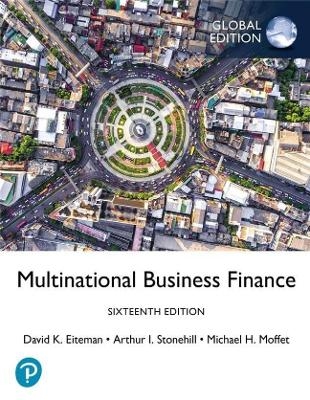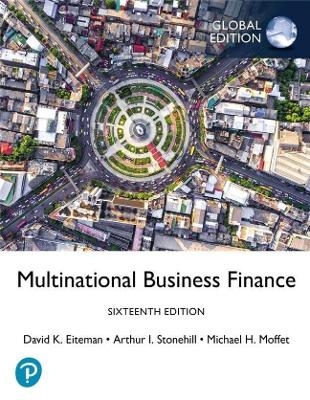
Multi–Asset Investing – A Practitioner′s Framework
John Wiley & Sons Inc (Hersteller)
978-1-119-24161-4 (ISBN)
- Keine Verlagsinformationen verfügbar
- Artikel merken
Having worked together for fifteen years, the authors present implementable solutions which have helped them successfully manage large asset pools. The Academic Perspective Multi-Asset Investing asks fundamental questions about the asset allocation investment processes in use today, and can have a substantial impact on the future structure of the finance industry. It clarifies and distils the techniques that investment professionals need to master to add value to client portfolios. Paul Smith, President & CEO, CFA Institute Pranay Gupta, Sven Skallsjo, and Bing Li describe the essential concepts and applications of multi-asset investing. Their treatment is far ranging and exceptionally lucid, and always with a nod to practical application. Buy this book and keep it close at hand. Mark Kritzman, MIT Sloane School of Management Innovative solutions to some of the most difficult investment problems we are faced with today. Multi-asset Investing tackles investment issues which don t have straight forward solutions, but nevertheless are faced by every investment professional. This book sets the standard for investment processes of all asset managers.
SP Kothari, MIT Sloane School of Management The Asset Owner Perspective Multi-asset means different things to different people. This is the first text that details a comprehensive framework for managing any kind of multi-asset investment problem. Further, its explanation of the commercial aspects of managing a multi-asset investment business for an asset manager, private bank or asset owner make it an indispensable tool Sadayuki Horie, Dy. Chairman - Investment Advisory Comm., Government Pension Investment Fund, Japan Multi-Asset Investing shows the substantial scope there is to innovate the asset allocation process. With its novel approaches to allocation, portfolio construction and risk management it demonstrates the substantial value that can be added to any portfolio. The solutions proposed by Multi-Asset Investing are creative, thought provoking, and may well be the way all portfolios need to be managed in the future. Mario Therrien, Senior Vice President, Caisse de Depot et Placement du Quebec, Canada The Asset Manager s Perspective Never has astute asset allocation and diversification been more crucial than today.
Asset Managers which are able to innovate their investment processes and products in this area, are more likely to be the winners. Multi-Asset Investing provides both simple and sophisticated, tested and implementable techniques for successfully managing multi-asset portfolios. Vincent Camerlynck, former CEO BNP Paribas Investment Partners, Asia Pacific The Investment Strategist Perspective For plan sponsors, portfolio managers, analysts and risk managers, Multi-Asset Investing is an unparalleled guide for portfolio management. Its approach to blending the quantitative and fundamental, top-down and bottom up and the risk and return frameworks makes it a valuable tool for any kind of investment professional. It clarifies a complex subject into a series of practical ideas to help add value to any portfolio. Ajay S. Kapur, Chief Strategist, BOA Merrill Lynch Asia
PRANAY GUPTA has over 25 years of experience in managing multi-asset and multi-strategy portfolios of up to US$85 billion across the world for asset managers, sovereign wealth funds, insurance companies, pension plans, endowments and high-net-worth individuals. He has served as the Chairman of the Investment Committee at the CFA Institute Research Foundation and has been awarded as the Best Discretionary Asset Manager in Asia. SVEN R. SKALLSJOE has designed and developed risk models at Ignis Asset Management, AGL Structured Finance and Shell Asset Management. BING LI is the president of BC Capital Management Ltd., a Hong Kong-based firm providing investment solutions for high-net-worth individuals in mainland China.
Preface About the Authors Chapter 1: An Introduction to the Multi-Asset Investment Problem 1.1 What is Multi-Asset Investing? 1.2 The Conventional Structure 1.3 Transitioning from Active Management to Exposure Allocation 1.4 Creating an Improved Allocation Structure 1.5 Constructing a Multi-Asset Portfolio to Manage Tail risks 1.6 Multi-Asset Investing in Emerging Markets 1.7 From Multi-Asset Strategies to Multi-Asset Solutions 1.8 Structuring a Multi-Asset Business Chapter 2: The Traditional Allocation Structure 2.1 The Traditional Investment Process 2.2 The Asset Allocation 2.3 The Belief in Diversification 2.4 Harnessing Equity Risk Premium and the Investment Horizon 2.5 Asset Classes as Mutually Exclusive Silos 2.6 Organization Structure and Resource Allocation 2.7 Implications for Skill Required in Asset Allocation 2.8 Requirements for a Revised Allocation Solution 2.9 Parallel Debates Created in the Search for a Revised Allocation Solution Chapter 3: Transitioning from Active Management to Exposure Allocation 3.1 A Historic Rationalization of Alpha and Beta 3.2 Progression of Active Management 3.3 Generalizing the Beta Concept 3.4 The Demise of Asset Class Demarcated Allocation 3.5 Implications for the Active Investment Process 3.6 Investment Strategy Categorization 3.7 Positioning of Alternative Investments 3.8 Obsolescence of Portable Alpha 3.9 Positioning of Fundamental Indexation and Smart Beta 3.10 Risk in an Exposure-Based Framework 3.11 Horizon-Based Organizational Demarcation 3.12 Transition from an Asset-Based to an Exposure-Based Organization 3.13 Conclusion Chapter 4: Redefining Risk Premium for Multi-Asset Allocation Decisions 4.1 Incumbent Risk and Risk Premium Frameworks 4.2 Framework for the Concurrent Presence of all Asset Classes 4.3 Incorporating Intra-Horizon Risk 4.4 Risk and Return Premium for Allocation Silos 4.5 Asset Class Premiums Comparison of Traditional and Proposed 6ethods 4.6 Asset Class Premiums Impact of different Investment Horizons 4.7 Asset Class Risk Comparison of Traditional and Proposed Methods 4.8 Asset Class Risk Impact of different Investment Horizons 4.9 Sovereign Risk and Risk Premium 4.10 Application to Various Multi-Asset Investment Problem Scenarios 4.11 Conclusion Chapter 5: A Multi-Strategy Allocation Structure 5.1 Categories of Allocation Approaches 5.2 A Multi-Strategy Framework for the Allocation Problem 5.3 The Benefits of Strategy Diversification 5.4 Individual Allocation Methodology Requirements 5.5 Example of a Multi-Strategy Allocation Approach 5.6 Conclusion Chapter 6: A Fundamental Exposure Allocation Approach - Business Cycles 6.1 The Passive Economic Model 6.2 An Active Economic Approach 6.3 A Five Cycle Asset Allocation Approach 6.4 Cycle Limiting Risk Parameters 6.5 Segregating the Core and Cyclical Components 6.6 The Composite Five Cycle Framework Chapter 7: A Systematic Exposure Allocation Process - Active Risk Budgeting 7.1 Modeling the Business Cycle 7.2 Modeling the Monetary Cycle 7.3 Risk Adjustment for Equity Valuation 7.4 Creating an Adjusted Risk Budgeting Allocation Methodology 7.5 Simulated Performance Results 7.6 Confirming Robustness of ARB Allocation Methodology 7.7 Implementation of a Drawdown Management Process Chapter 8: Estimation of Asset Allocation 8.1 The Consensus Asset Allocation Dataset 8.2 Using Consensus Data for Allocation Decisions Chapter 9: Optimization for Multi-Asset Portfolios 9.1 Evolution of the Mean Variance Framework 9.2 Portfolio Allocation and Measures of Performance 9.3 A Utility Based Approach 9.4 The Fund Manager s Objectives 9.5 The Efficient Frontier 9.6 Optimal Portfolio Choice 9.7 Incorporating the Constraints 9.8 Tail Risk Constraint 9.9 Event Risk 9.10 Macro Risk 9.11 Regime Risk 9.12 Correlation Risk 9.13 Formulation of the Optimization Problem 9.14 The Unconstrained Allocation 9.15 Applying the Constraints 9.16 The Preferred Portfolio Chapter 10: Managing Tail Risk in Multi-Asset Portfolios 10.1 Portfolio Management the Practical Setting 10.2 Asset Allocation the Practical Setting 10.3 Creating a Real Risk Measure: End-of-Horizon vs. Intra-Horizon Risk 10.4 Model Uncertainty 10.5 Stop-Losses 10.6 Implementing Tail Risk Management Notation and Variables Chapter 11: Multi-asset Investing in Emerging Markets 11.1 Implementing Tail Risk Management 11.2 Observation 2: Inappropriate Sector Classification for Emerging Markets 11.3 Observation 3: Stock Concentration in Equity Indices 11.4 Observation 4: The Potential for Active Management 11.5 Observation 5: Performance of Active Managers 11.6 Observation 6: Over-Dependence on a Single Investment Decision 11.7 Summary of Observations 11.8 Pitfalls in Emerging Market Investment Frameworks 11.9 An Improved Framework for Emerging Market Investments Chapter 12: The Importance of Asset Allocation in Asian Equities 12.1 Impact of Breadth on Portfolio Excess Return 12.2 Impact of Varying Cross-Sectional Dispersion on Portfolio Excess Return 12.3 The Relative Importance of Asset Allocation and Stock Selection 12.4 Comparing the US and Asian Equity Investment Universe 12.5 Conclusions Chapters 13: Implementing a Multi-Asset Strategy Active or Passive 13.1 Investment Determinants for the Active-Passive Decision 13.2 Asset Owner Constraints impacting the Active Passive Decision Chapter 14: An Exposure Based Risk Diagnostics Framework 14.1 Shortcomings of a Traditional Risk Analysis Approach 14.2 Evaluating Intended and Unintended Risk 14.3 A Multi-Dimensional Risk Architecture Chapter 15: Impact of Manager Compensation on Allocation Decisions 15.1 Compensation Structure 15.2 Managerial Constraints 15.3 Optimal Activeness 15.4 The Distribution of Performance 15.5 The Importance of Skill 15.6 Activeness and Age 15.7 Implications for a Multi-Period Setting 15.8 Examples of Managerial Contracts 15.9 Conclusions Chapter 16: From Multi-Asset Strategies to Multi-Asset Solutions 16.1 Current Phase of Industry Transition 16.2 Multi-Asset Solutions as an Industry Function 16.3 Characteristics of a Multi-Asset Solution Provider 16.4 Customization Parameters for an Investment Solution 16.5 Requirements for a Standardized Implementation 16.6 The Importance of Attributing Performance 16.7 Conclusions Chapter 17: Multi-asset Investing for Private Wealth Assets 17.1 The Private Wealth Multi-Asset Investment Problem 17.2 Business Model and Organizational Issues 17.3 Incumbent Investment Frameworks 17.4 A Multi-Asset Private Wealth Investment Platform 17.5 Goals-Based Allocation 17.6 Implication for the Long-Only Active Manager 17.7 Conclusions Chapter 18: Structuring a Multi-Asset Investing Business 18.1 Product Structure and Positioning 18.2 Product Advantages and Disadvantages 18.3 Product Investment Skills 18.4 Target Client Segmentation 18.5 Where Did Existing Products Fall Short? 18.6 Client Segment Expectations and Evaluation Chapter 19: Enhancing the Institutional Investment Process and Ways to Compete for Better Outcomes 19.1 Mission and Beliefs The First and Most Critical Step 19.2 Frameworks: Traditional Asset Class Versus Risk Premium 19.3 Linking Beliefs With Return Drivers and Portfolio Construction Decisions 19.4 Governance Consideration 19.5 Choosing an Implementation Route for Delegation 19.6 Monitoring Bibliography and References Index
| Verlagsort | New York |
|---|---|
| Sprache | englisch |
| Maße | 152 x 229 mm |
| Gewicht | 666 g |
| Themenwelt | Wirtschaft ► Betriebswirtschaft / Management ► Finanzierung |
| ISBN-10 | 1-119-24161-8 / 1119241618 |
| ISBN-13 | 978-1-119-24161-4 / 9781119241614 |
| Zustand | Neuware |
| Haben Sie eine Frage zum Produkt? |
aus dem Bereich


